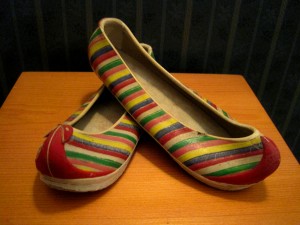Becoming Realer: Identity, Craft and the MFA is a column that explores issues of poetry, theory and writing craft in relation to the personal experiences of Saint Mary’s College of California Creative Writing MFA candidate and LR staff writer, Kelsay Myers.

I can’t remember if I imagined Korea as a child. I must have. I put the rainbow-striped shoes that were sent with me from Busan when I was three-months old high on a shelf in my bedroom, in a place where I could look at them but not touch them. Sometimes, I would ask my mother to take down the shoes, wondering if that would be the day they’d finally fit on my feet. That day never came. They were too big each time. I’d fall down trying to walk in them. Eventually I forgot about wanting to wear them, and when I did remember they were up on that shelf again, they were so small that they pinched my feet. I used to think the moral of this story was that the shoes never fit just right. That, in the same way, Korea would never fit just right, but now I see even greater meaning in the fact that I was the one who put the shoes in a place where I could look at them, but not feel them.
That is the true moral of the story. I’m still afraid to feel Korea. It’s more comfortable in the abstract, or as a rainbow-colored shoe that will never fit, than as an actual thing that I can put my arms around or stick my feet in. It’s more comfortable as a symbol than a country, as a metaphor than a reality.
I’m still uncomfortable with making Korea a real place, a place that I can picture when I close my eyes, or smell or taste. I was supposed to be researching Busan this past month for my Foundations of Contemporary Literature class because I’ve chosen to revise my lyrical essay, “The Red Frame” (which I mentioned in my last post), for my final research project. I spent the past month reading about cognitive processing of emotions, such as happiness, sadness and fear, or the role of imagination in the narratives and identities of transnational adoptees instead of reading about Busan or fishermen in order to flesh out a scene to juxtapose against my formal adoption story.
The story goes that my birth father was a poor fisherman who lost his arm in a boating accident, and the family already had two sons to support. They wanted me to have a better life, so they surrendered me for adoption. Now, this story has lived in my imagination since I was a young girl. Sometimes, I’ve liked it and agreed with it. Sometimes, I’ve been skeptical of its truthfulness. Sometimes, I’ve thought that if I had been born a boy, they would have found a way to scrape by. But when faced with the task of coming up with imagined alternatives that involve real aspects of Korean society and specific notions of place, I hesitate.
At this point, I have done some research on the Jagalchi Fish Market, and I have the basic outline of a scene or two in my head that take place there. Yet, when I do a Google Image search of the Nampodong district in Busan where the fish market is located, a sense of unease creeps in. It’s the same unease I felt the first time I saw a picture of Busan, the fifth largest port city in the world and second largest city in South Korea. So yes, I did imagine it. I imagined it to have rolling rice fields and farms filled with pigs, chicken, cattle and dogs. Instead I saw bright colored signs, tall buildings and crowded city streets. When coming face-to-face with the real, I recoiled. I lost interest, and as a result, I’ve forgotten a lot of what I learned about Korea in childhood. And now, almost sixteen years later, I’m here once again attempting to learn about Korea. And even as I yearn to become “realer,” I balk and have the intense urge to put the shoes back where I can’t feel them again.